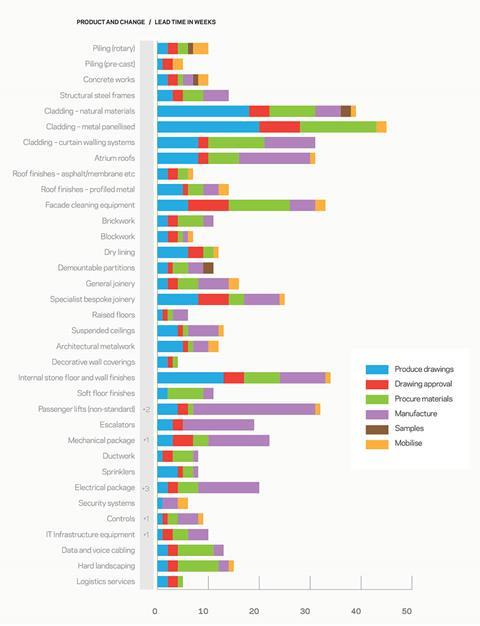Lead times have either remained the same or increased, with burgeoning workloads and enquiries and a shortage of skilled labour making further increases more likely
01 / Going up
▲ Passenger lift - non-standard
▲ Electrical packages
▲ Mechanical packages
▲ Controls
▲ IT infrastructure equipment
02 / Staying level
▶ Sprinklers
▶ Concrete works
▶ Structural steel frames
▶ Brickwork
▶ Cladding (reconstituted stone)
▶ Cladding (natural materials)
▶ Metal panellised cladding
▶ Curtain walling
▶ Atrium roofs
▶ Asphalt/membrane roof finishes
▶ Profiled metal roof finishes
▶ Brickwork
▶ Blockwork
▶ Drylining
▶ Metal doors
▶ Demountable partitions
▶ General joinery
▶ Specialist joinery
▶ Raised floors
▶ Suspended ceilings
▶ Decorative wall covering
▶ Non-standard passenger lifts
▶ Escalators
▶ Internal stone floor and wall finishes
▶ Ductwork
▶ Security systems
▶ Logistics services
▶ Soft floor finishes
▶ Architectural metalwork
▶ Hard landscaping
▶ Pre-cast piling
03 / Lead times summary
Rotary piling ▶ companies are reporting no change in lead times for this quarter but as a result of improved data the lead time has been restated at 10 weeks.
Pre-cast piling ▶ lead time remains at 5 weeks, following total of four weeks reduction in the past nine months. Concrete works ▶ lead times remain at 10 weeks. Specialist contractors do not anticipate further increases over the next six months. Structural steel frames lead times remain at 14 weeks. No major change is anticipated in the next six months.
Cladding ▶ natural material lead times remain at 39 weeks for the second quarter in succession following the four-week increase six months ago.
Cladding ▶ metal panellised system lead times remain at 45 weeks for the second successive quarter following the six-week increase six months ago. Further increases to lead times are anticipated.
Cladding ▶ curtain walling system lead times have been restated at 31 weeks having secured a better data sample. Contractors do not expect lead times to increase over the next six months.
Atrium roof ▶ lead times remain at 31 weeks and roof finishes - asphalt / membrane ▶ lead times at seven weeks. Roof finish - profiled metal ▶ lead times have remained at 14 weeks for a year.
Facade cleaning equipment ▶ lead times remain at 33 weeks. Companies continue to be busier but anticipate no lead time increase in the next six months.
Brickwork ▶ lead times remain at 11 weeks and blockwork ▶ at seven weeks. Companies do not expect lead times to increase over the next six months.
Drylining ▶ lead time remains at 12 weeks with no increases anticipated in the next six months.
Demountable partitions ▶ lead times remain at 11 weeks, no further increases are anticipated.
General joinery ▶ lead times remain at 16 weeks following one week increase six months ago.
Specialist joinery ▶ lead times remain at 25 weeks following the increase by two weeks last quarter. Further increases are anticipated.
Raised floors ▶ lead times remain at six weeks despite being busier with workload and enquiries. Suspended ceiling ▶ lead times remain at 13 weeks.
Architectural metalwork ▶ remains at 12 weeks following an increase by one week last quarter. With enquiries down no further increases are anticipated.
Decorative wall covering ▶ lead times remain at four weeks with no change anticipated. Internal stone floor and wall finish ▶ lead times remain at 34 weeks following an increase of one week last quarter. No further increases are anticipated.
Soft floor finish ▶ lead times remain at 11 weeks following increases last quarter, but further increases are anticipated over the next six months.
Passenger lift - non standard ▲ lead times have increased by two weeks to 32 weeks, workload and enquiries remain the same with no further change in lead times forecast for the next six months. Escalator ▶ lead times remain at 19 weeks.
Electrical packages ▲ lead times have increased by three weeks to 20 weeks, this is mainly due to increases in manufacturing. Lead times are not forecast to increase in the next six months.
Mechanical packages ▲ lead times continue on a steady increase following a slight respite last quarter, with an increase this quarter of one week to 22 weeks.
The lead time for ductwork ▶ remains at eight weeks and sprinklers ▶ lead times remain at eight weeks.
Security systems ▶ lead times remain at six weeks.
Controls ▲ lead times are fluctuating with an increase of one week to nine weeks following the decrease last quarter. No further increases are anticipated.
IT infrastructure ▲ equipment s lead times have increased by one week to 10 weeks due to increased workload. Despite strong enquiry levels no further increases are anticipated in the next six months.
Data and voice cabling ▶ remain at 13 weeks but change is forecast due to increased workload.
Fire detection and voice alarm systems ▶ lead times remain at 11 weeks.
Hard landscaping ▶ lead times remain at 15 weeks.
Logistics services ▶ lead time remains at five weeks with no change forecast in the next six months.
Lead times continue to either remain stable or increase, with the focus of the increases being on the M&E-related packages. Contractors continue to report increase workload and enquiries with the availability of skilled labour being a significant factor in future forecast increased lead times. Packages with a major design element report delays in getting design approvals which they are absorbing in improvements in other areas, but anticipate it could increase lead times in the longer term.
Data capture and analysis by Mace Business School. For more details on the article and contributors, please visit

























No comments yet